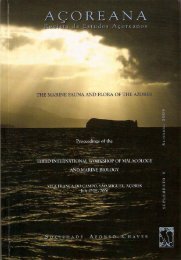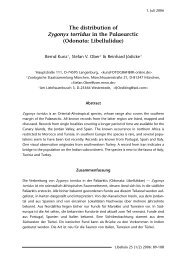On the taxonomy and natural history of Oxypoda brachyptera and O ...
On the taxonomy and natural history of Oxypoda brachyptera and O ...
On the taxonomy and natural history of Oxypoda brachyptera and O ...
Create successful ePaper yourself
Turn your PDF publications into a flip-book with our unique Google optimized e-Paper software.
Beitr. Ent. 62 (2012) 1<br />
Material <strong>and</strong> methods<br />
The material treated in this study is deposited in <strong>the</strong> following public institutions <strong>and</strong> private collections:<br />
BMNH The Natural History Museum, London (R. G. Booth)<br />
SDEI Senckenberg Deutsches Entomologisches Institut, Müncheberg (L. Zerche)<br />
cAss author´s private collection<br />
cSch private collection Michael Schülke, Berlin<br />
Morphology <strong>and</strong> anatomy:<br />
The morphological studies were conducted using a Stemi SV 11 microscope (Zeiss Germany) <strong>and</strong><br />
a Jenalab compound microscope (Carl Zeiss Jena). For <strong>the</strong> photographs a digital camera (Nikon<br />
Coolpix 995) was used.<br />
Elytral length was measured at <strong>the</strong> suture from <strong>the</strong> apex <strong>of</strong> <strong>the</strong> scutellum to <strong>the</strong> posterior margin<br />
<strong>of</strong> <strong>the</strong> elytra. The length <strong>of</strong> <strong>the</strong> median lobe <strong>of</strong> <strong>the</strong> aedeagus was measured from <strong>the</strong> apex <strong>of</strong> <strong>the</strong><br />
ventral process to <strong>the</strong> base <strong>of</strong> <strong>the</strong> capsule.<br />
The parameral side <strong>of</strong> <strong>the</strong> median lobe <strong>of</strong> <strong>the</strong> aedeagus (i.e., <strong>the</strong> side where <strong>the</strong> sperm duct enters)<br />
is referred to as <strong>the</strong> ventral, <strong>the</strong> opposite side as <strong>the</strong> dorsal aspect.<br />
The abdomen <strong>of</strong> several thous<strong>and</strong> females was dissected to examine <strong>the</strong> condition <strong>of</strong> <strong>the</strong> ovaries.<br />
The presence <strong>of</strong> mature eggs was interpreted as evidence <strong>of</strong> oviposition activity. In all <strong>the</strong> studied<br />
specimens <strong>the</strong> length <strong>of</strong> <strong>the</strong> hind wings was recorded. In order to assess <strong>the</strong> presence or absence<br />
<strong>of</strong> flight muscles, <strong>the</strong> thorax <strong>of</strong> more than a hundred macropterous specimens was dissected by<br />
removing <strong>the</strong> dorsal portion <strong>of</strong> <strong>the</strong> thoracal ectoscleleton.<br />
Ecology:<br />
During a period <strong>of</strong> more than two decades (1981-2001), field studies were conducted on <strong>the</strong><br />
staphylinid fauna <strong>of</strong> a variety <strong>of</strong> habitats, particularly Calluna heathl<strong>and</strong>s on s<strong>and</strong>y soils, in<br />
Niedersachsen, nor<strong>the</strong>rn Germany. These studies yielded more than 100,000 adult Staphylinidae<br />
<strong>and</strong> more than 15,000 larvae. The localities where ei<strong>the</strong>r <strong>Oxypoda</strong> <strong>brachyptera</strong> or O. tarda were<br />
recorded are listed in Tab. 1. For more details on <strong>the</strong>se sites see Assing (1988, 1992, 1993, 1994),<br />
H<strong>of</strong>meister et al. (2001) <strong>and</strong> Melber et al. (1996).<br />
In all <strong>the</strong> study sites pitfall traps were used to assess <strong>the</strong> species inventory <strong>and</strong> seasonal activity.<br />
The number <strong>of</strong> pitfall traps varied between three <strong>and</strong> 52 per year <strong>and</strong> site. For details regarding<br />
<strong>the</strong> type, construction, <strong>and</strong> maintenance <strong>of</strong> <strong>the</strong> pitfall traps see Melber (1987). The traps<br />
remained installed throughout <strong>the</strong> year (i.e., also in winter) <strong>and</strong> were emptied at half-monthly<br />
intervals, in some sites at monthly intervals. The data shown in Figs 26-27 are exclusively based<br />
on those full-year studies with pitfall traps that were emptied at half-monthly intervals. In all,<br />
more than 700 one-year pitfall traps were installed <strong>and</strong> maintained.<br />
In addition to pitfall trapping, soil extractions after Kempson et al. (1963) were conducted<br />
in several heathl<strong>and</strong>s to assess <strong>the</strong> densities <strong>of</strong> Staphylinidae. The samples were taken at halfmonthly<br />
intervals throughout <strong>the</strong> year. For more information on <strong>the</strong> field methods used see<br />
Assing (1993).<br />
209
















